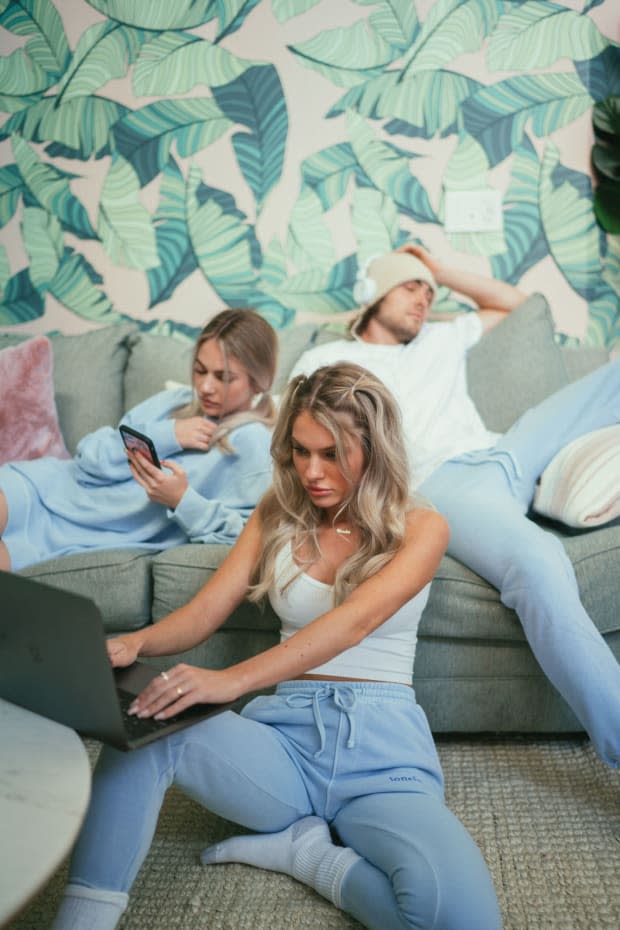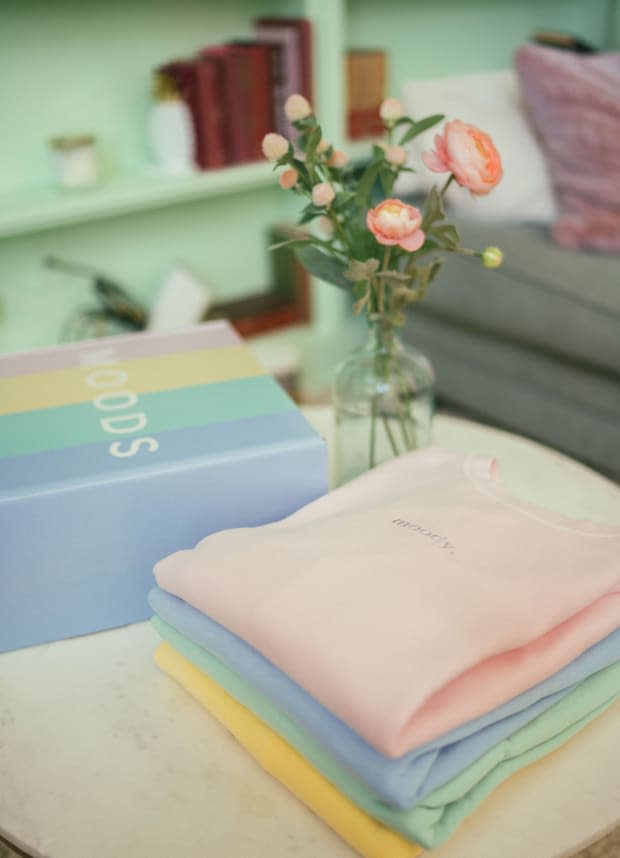On TikTok and YouTube, Building Your Empire Starts With Merch
No follower count is too small to drop a line of tees with your face on it. But for creators, that's not always what moves the needle.
When Brandon Walsh was 13 years old, he presented his parents with what he believed to be a lucrative business opportunity: With a small investment, he said, you could be part of an apparel company that, like most great clothing enterprises of the mid- to late-aughts, would start with a branded line of merchandise.
And so Brandon began printing skateboarding tees his mother designed to sell on-site at middle school. In what was perhaps a testament to his entrepreneurial prowess, however, it didn't take long for the administration to shut down the operation. Apparently, he learned, it's inappropriate for a teenager to be turning a profit while simultaneously learning how to solve linear equations.
Last fall, Brandon, now 26, made a return to selling clothing to his peers, but this time, his consumer base had been upgraded to fellow content creators on platforms like YouTube and TikTok. He had new business partners, too, subbing out his encouraging parents for younger sisters Claudia, 24, and Kennedy, 21, who enjoy sizable follower counts of their own.
This is the origin story of Moods Clothing, owned by the Walsh siblings and run out of Baltimore, where Brandon, Claudia and Kennedy are based. I should be careful not to draw too straight of a line between Moods and Brandon's adolescent enterprise, though, because Moods is not merch.
Instead, per the Walshes' own definition, Moods is a standalone clothing brand that right now benefits from the success of the siblings' respective and communal platforms. Here's what Moods is not: a T-shirt line centered around some element of their likeness, with the cotton-blend items printed on-demand via a user-submitted marketplace like Redbubble.
"Every creator, at some point, gets to the point where they’re going to end up creating merchandise," Brandon tells me over Zoom. "When an influencer makes merchandise, they usually partner with a third-party company and the merch is very much about them. But it's not really about the community. We wanted to create a clothing line that's more so for the community, versus just being a reflection of us."

This is not meant to disparage merch, which can be extremely profitable both financially and professionally. But with more and more content creators now playing the long game, personalized merch — traditionally speaking — is often just one small step toward a more strategic branded empire.
The Walshes and I are, admittedly, a few years apart in age, but I remember a time in my millennial life when merch was ubiquitous. The bubbly Y2K era is still inseparable from the boy band lunch boxes that once temperature-controlled our Gogurts and a bit more cerebrally, enabled us to be small, non-voting shareholders in our favorite groups. Eventually, we grew up, but our merch didn't.
Related Articles
The Influencer of the Future Is Here, and They Don't Want to Sell You Anything
Dear Fashion Brands: Why Aren't You on TikTok?
TikTokers Have a Flashy New Secret Weapon: Fashion Stylists
By 2016, fan gear started making a comeback. Artists like Beyoncé, Justin Bieber and Kanye West began producing apparel that fell more in line with a limited-edition fashion line than a boardwalk T-shirt stand. Bieber lost the boyish shag around the same time he began collaborating with Fear of God designer Jerry Lorenzo on garments with nods to Thrasher and Vetements.
"For a big name like Bieber or Beyoncé to start caring more about merch, bands are recognizing the fact that this experience goes 360 degrees," merch designer Brandon Rike told Fashionista's Maria Bobila in 2016. "We can put the fan in a complete ecosystem of the brand."
This is not unique to the entertainment industry: With increasingly congested marketplaces, these 360-degree "experiences" have become requirements for any brand looking to break through the noise. Merch, of course, is one small way to do that, which is why the last six years have brought us food merch and collegiate merch and fictional world merch and church merch and mental health merch and even makeup artist merch. Creator merch, really, is no different.
"If you're a niche creator and you build this cool community, having merch is kind of a signal [for your followers], as in, 'Oh, you like this creator, so that means you're this kind of person,'" Vox Senior Reporter Rebecca Jennings explains. "That's more like something 30-year-olds would do, wearing a hat of their favorite podcast or a tote bag from the website they read the most."
View the original article to see embedded media.
People are already used to buying merch, whether it comes from a prestigious literary magazine or a TikToker who first started filming dance videos in her Louisiana State University dorm room. Jennings argues that for creators, producing merch lines has become a low-lift status symbol on par with, say, making a T-shirt for your high-school field hockey team.
"You're not actually doing anything besides joining a [print-on-demand] site like Redbubble or Fanjoy and putting a design on it," she says. "So to me, this is just what you do once you get a certain amount of followers, and that threshold is changing a lot. I've seen kids who have one viral video and they're like, 'MERCH COMING SOON!'"
Do creators have a lot to gain, monetarily speaking, from dropping crewnecks emblazoned with their side profile the moment they start growing an audience? Yes, in that some funds are better than no funds at all. Many fledgling creators tend to work with third-party companies under the agreement of a 50-50 revenue share wherein the producer in question does the majority of the work, including printing, packaging and shipping, while the creator reaps half of the profits. It's a good gig for creators who consider merch a short-term investment in a long and prosperous online future. After all, everyone joins TikTok with zero followers. You have to start somewhere.
"With TikTok, you can get famous super, super fast," Jennings says. "You might not be rich. You might have to put years of work into your content. Ultimately, you're finding ways to cash out quickly, and merch is one way to do that."
Sometimes, TikTok fame may move too fast to entertain (let alone to release) merch in the first place. In early 2020, the internet was aflutter with talk of a content-creator mansion called the "Hype House," a 19-member collective of TikTok's biggest handles. When The New York Times published its viral profile of the group in January of last year, gear wasn't in the picture.
"At some point if they want to do a pop-up shop, or release Hype House merch, they need to figure out how to divvy things up financially and they're going to have to legitimize it as a business," MaiLinh Nguyen, a former videographer for Jake Paul, told the paper. The writing was on the wall: Hype House began disbanding soon after, with the collective effectively gutted by summer.

The gradual dissolution of Hype House has been far from the end of the road for its members. A slew of Hype House creators joined the collective with a few hundred-thousand followers and left with blue-chip deals with talent agencies, cosmetic conglomerates and fashion houses. Now, they're even past the point of releasing merch of their own.
"If you talk to influencer managers, I bet some of them would say that it's not always the best idea to rush into merch because it might muddy your brand, and instead wait for something big," Jennings says. "[Addison Rae] and [Charli D'Amelio] have deals with actual beauty brands that are, obviously, much more lucrative than selling a T-shirt with their face on it."
Back in Baltimore, the Walshes spend the duration of our conversation huddled together on one couch discussing factors like thread counts, colorways and scalability. They're proud of the brand they're building because that's what it is: a brand, and one their community can see themselves in.
"It was really making it about things we knew a lot of people could relate to, and we knew there were a lot of the reasons people follow us to begin with," Kennedy says. One of those reasons, the siblings cite, is that they're always open to discuss their mental state, even at their most vulnerable. It's why their garments sport words like "lonely," "moody" and "bad" on banana sweatpants and minty crewnecks. "We really wanted it to be like a reflection of our viewers," she adds.
Claudia, who handles the marketing end of the operation, has been intentional to never promote Moods as merch for that reason: "It's a clothing line, not promo for YouTube," she says.
The siblings are hopeful this a distinction they won't have to make for long, particularly as they're able to start scaling the team.
"Our next step is to push it past just being a brand for the YouTube community," Brandon says. "We definitely want to make it a clothing brand that anyone can wear and isn't just dependent on our YouTube channel for its success. We want it to grow beyond that."
Never miss the latest fashion industry news. Sign up for the Fashionista daily newsletter.